What are WordPress blocks, and how can you use them? Are there ways to further enhance the Gutenberg blocks editor with more features? And what if you don’t like Gutenberg and want to return to the Classic WordPress editor? I will answer all these questions right here, so be sure to stick around.
Table of Contents
What are WordPress Content Blocks?
Since version 5.0 of WordPress was launched in December 2018, WordPress has had a new way to edit posts and pages, called the Gutenberg editor. Previously, you edited WordPress posts, and pages in a text-based editor called the Classic editor. But now, with Gutenberg, you can create and edit posts and pages by adding blocks and positioning them on the page.
Gutenberg Blocks
Gutenberg blocks are the blocks of content that you use to build a page or post in the Gutenberg editor. For example, these blocks can be paragraph text, headings, images, videos, quotes, tables, buttons, and many other types of website content. The WordPress website has a complete list of blocks.
Here is an example of a blog post being edited with the Gutenberg blocks editor:
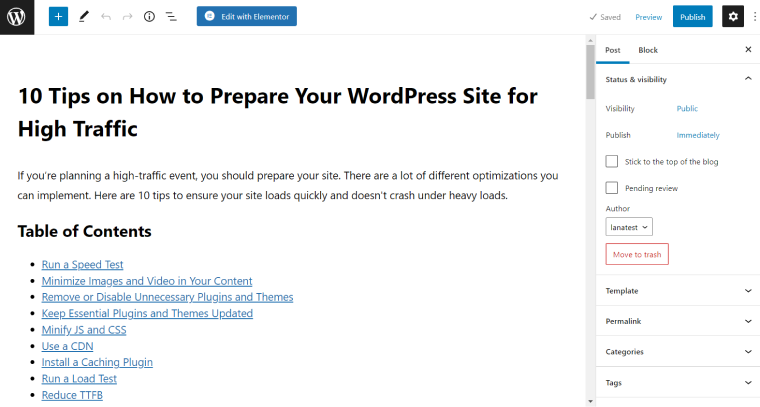
Here is the same blog post being edited with the Classic editor:
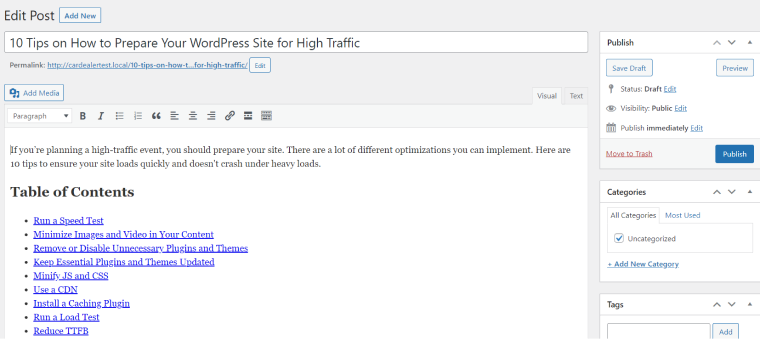
Expanding the Gutenberg Editor with Plugins
Although WordPress has many blocks to use in your posts and pages, it could be better and needs some important features. Sometimes, you might want to add something not included in the standard Gutenberg blocks.
Thankfully, many Gutenberg Blocks Plugins are available for WordPress – both free and paid.
These give you more block types, including forms, grids, social media blocks, image galleries, and much more.
How to Use Blocks in WordPress
So, hopefully, you now have a general understanding of what WordPress blocks are. Let’s now get into how to use them to create and edit your WordPress posts and pages.
Adding a WordPress block
In a new or existing post or page, click the plus sign in the top-left of the editor:

Alternatively, you can hover your mouse over a place in between blocks within the content. This causes a plus icon to appear, which you can click. If you insert a block using this method, it will get inserted into the content in that location.
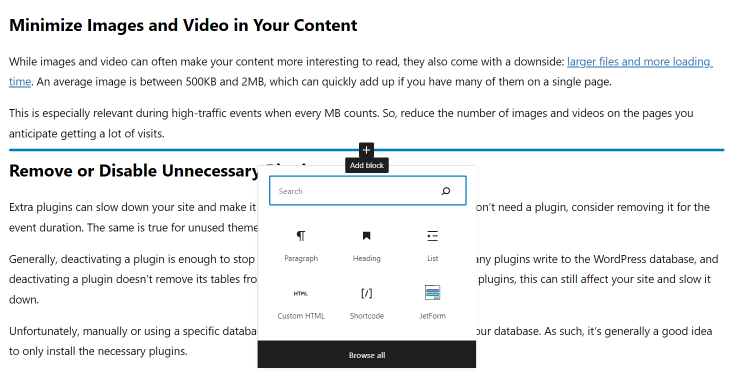
Customizing a WordPress block
If you want to customize a block, click on the block within the editor. You will notice that this brings up a floating toolbar above the block. You can change the block type, alignment, text format, etc.
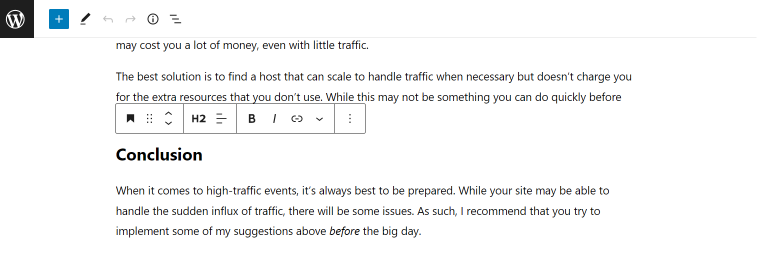
You may also notice the area to the right that contains more advanced block settings. Here, you have detailed control over the appearance and function of the block.
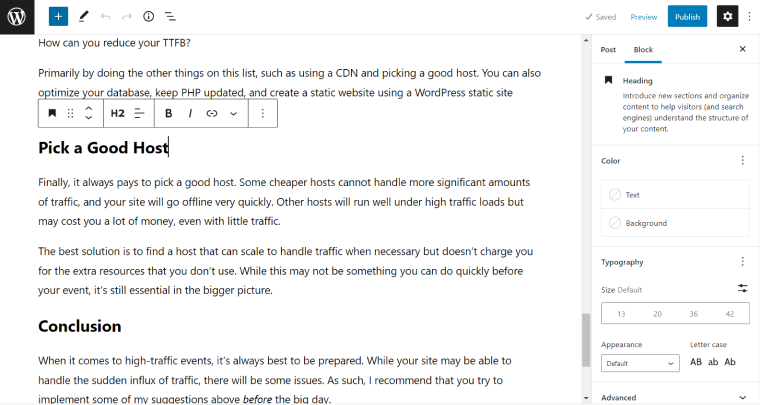
Selecting blocks using the list view
Most of the time, you won’t have a problem finding the block you want to edit and then clicking it. However, if you are editing a very large page of content, there may be so many blocks that it can take time to find the specific block you want to edit.
This is where the list view comes in useful. To open the list view, click the list icon in the top-left of the editor.
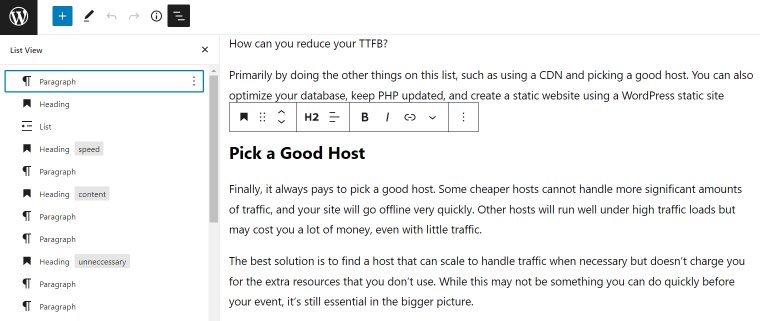
This brings up a window to the left that displays a list of all the blocks in your post or page. In the list view, you can quickly select a specific block.
Rearranging WordPress blocks
Another helpful thing you can do in the list view is to move blocks around by clicking and dragging them up and down the list.
There are also two ways to rearrange blocks without using the list view. One way is to click the up or down arrow in the floating toolbar when you click on a block.
The other way to rearrange blocks is to click the six dots on the floating toolbar and drag it into a new position within the content.
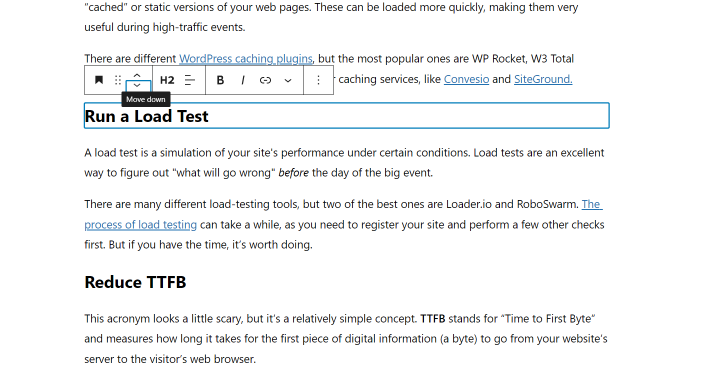
Moving multiple blocks
There might be times when you need to move multiple blocks to a different position within the post or page. Moving one block at a time would be too time-consuming in such situations. Thankfully, there are several ways you can easily move several blocks at the same time.
One way is to click and drag your mouse and select all the blocks you want to move, just as you would when choosing several paragraphs in a document.
At that point, you have two options. First, you can click the six dots in the floating toolbar and drag the blocks into position.
The other option is to use the up or down arrows in the floating toolbar to move the multiple blocks up or down within the post or page.
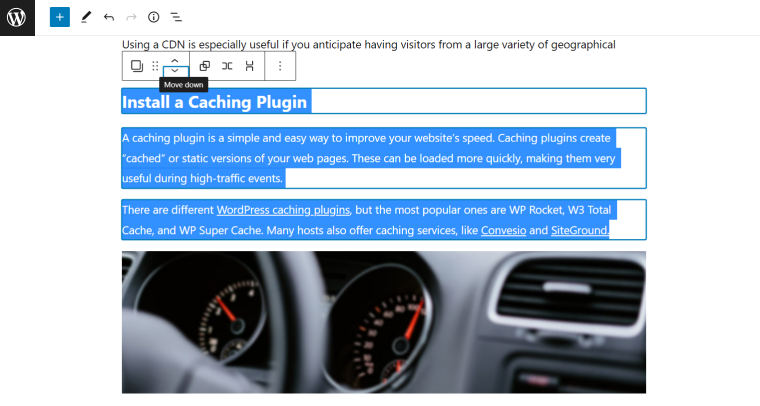
However, you can also move multiple blocks within the list view. Click the list icon to open the list view, hold down the Shift key, and select all the blocks you want to move. Then you can drag them into a different location within the list.

Putting WordPress blocks side-by-side in columns
Until now, it might have seemed like you could only have a block in each vertical position within your post or page. Well, actually, you can have blocks side-by-side.
To do this, you need to use the Columns block. When you go to add the Columns block, you will have a choice of layouts, as shown in this screenshot:
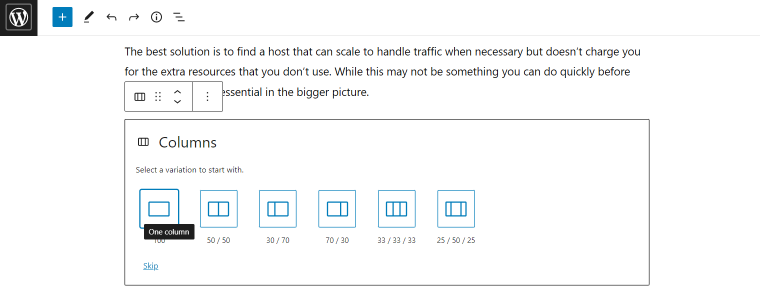
Once you have chosen a column layout, you will notice that each column has a plus icon. Clicking those plus icons will allow you to insert blocks into those columns. You can even add column blocks within columns, giving you more elaborate column layouts.
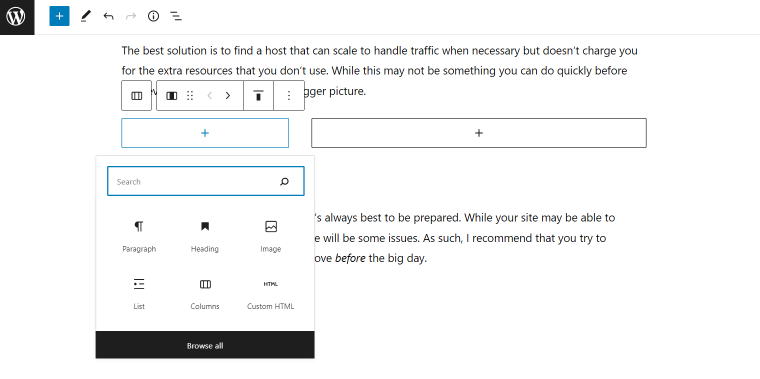
If you change your mind about the column layout later, don’t worry. You can easily change the layout afterward. The easiest way to do this is to use the list view to select the columns block. You will then be able to adjust the settings in the section over on the right.
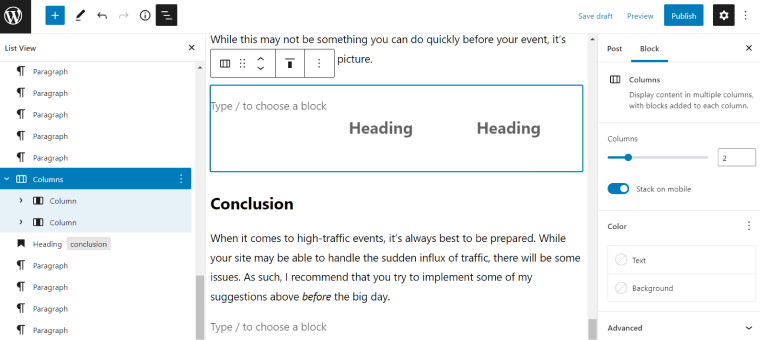
If you need to adjust the size of individual columns, you can select a column within the list view, then set the percentage or number of pixels.
Grouping WordPress blocks together
Did you know that you can group blocks? This can be very useful if you want to apply certain attributes to a set of blocks, for example, a background color.
To create a group, you first need to add the Group block. To do this, bring up the block inserter by clicking the plus icon and selecting the Group block.
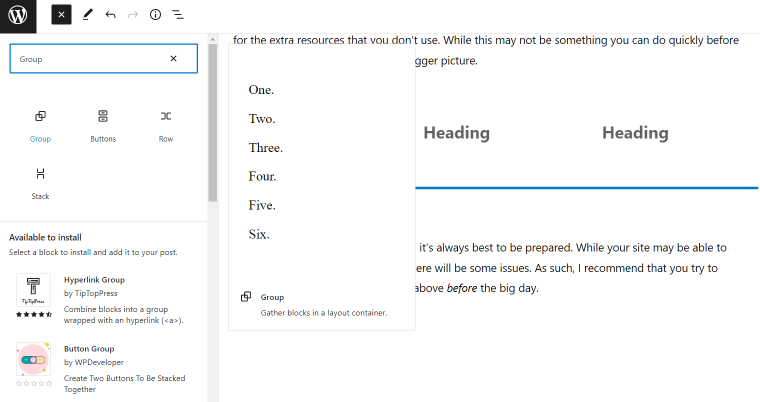
Then, you can click the plus icon within the Group block to add new blocks to it.
Alternatively, you can drag existing blocks into the Group block by selecting a block, clicking the six dots on the floating toolbar, and dragging the block into the Group block.
Once your Group block has blocks within it, you may need help selecting the Group block to make changes to it. If so, you will probably find it easier to choose the Group block from within the list view.
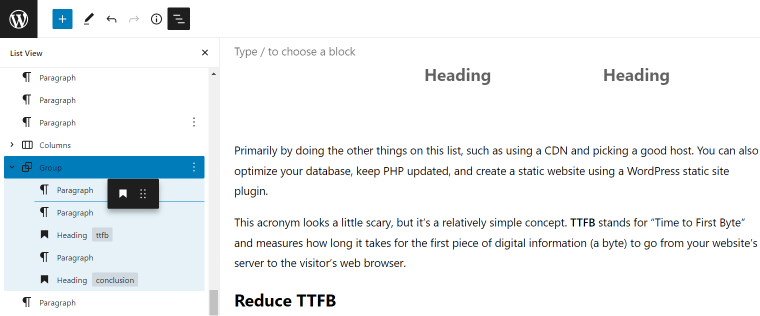
Copy and paste WordPress blocks
Sometimes you want to copy existing content to reuse it on the same page. If that is paragraph text, you can copy and paste it just as you would in a standard Word document — “Ctrl/Cmd + C” to copy, followed by “Ctrl/Cmd + V” to paste. This also seems to work with images.
But for other block types, you will need to do it this way instead:
- Select the block.
- Click the three dots on the floating toolbar that appears.
- Select Duplicate.
You can then move that duplicate block to wherever you want it to be and edit it if you wish.
What if You Don’t Like Using WordPress Blocks?
For many people, the Gutenberg blocks editor is a more intuitive way of building content. Even if Gutenberg still has some room for improvement, for many, it is a big step in the right direction.
However, some people still prefer the old WordPress editor, with its simple text-based interface. If that’s true for you, what can you do?
Thankfully, there is a way to still use the Classic editor within WordPress by installing a plugin. Here are two that are worth trying.
Disable Gutenberg plugin
The default setting for this plugin is for the Gutenberg editor to be disabled for all users, including administrators. However, you can change this setting and instead customize the editor options for different user roles, such as admins, editors, authors, and contributors.
Classic Editor plugin
Once you have installed this plugin, the Gutenberg blocks editor will be disabled and replaced by the old WordPress editor. However, you can set it so that both editors are available. This could be useful if more than one person is editing your website and they have different preferences.
A word of warning, though: this plugin has not been updated for over a year, so it has not been tested with the latest version of WordPress.
FAQ
WordPress blocks are individual content that you can insert into your post or page and then move into a specific position within the content. Examples include headings, paragraph text, images, and videos.
You can easily rearrange your WordPress blocks by clicking the six dots on the floating toolbar, dragging the block into a different position, or clicking the up or down arrows on the floating toolbar. You can also move them within the list view.
When you click on a block in WordPress, you will notice a floating toolbar appears above it. You will also notice some more advanced settings in the pane to the right of the content.
Yes, all installations of WordPress since version 5.0 come with the Gutenberg blocks editor as standard.
The easiest way to create a custom block is to use one of these Gutenberg block plugins.
That’s a matter of personal preference and depends on what you are trying to do on your website. Try the Gutenberg editor first, but if you need more features, you can also try Elementor, as it has a free version.
WordPress Blocks: a Step in the Right Direction
Now you know everything you need to know about WordPress blocks and how to use them. WordPress has come a long way since it was first released in 2003, and the Gutenberg blocks editor is a big step in the right direction.
Of course, if you find that the standard blocks offered by WordPress don’t offer quite what you are looking for, there are various plugins available to enhance WordPress with more features.